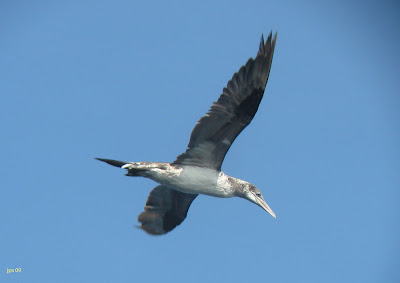 Wilson's Storm-petrel. Jeffreys Ledge, NH. July 22nd, 2009.
Wilson's Storm-petrel. Jeffreys Ledge, NH. July 22nd, 2009.
Susannah, Matan and I took the afternoon boat to Jeffreys Ledge with the Granite State Whale Watch from Rye Harbor. Although a little choppy going out, it turned out to be a beautiful calm afternoon on the ocean with 'tubenoses' in good numbers once we arrived at Jeffreys Ledge. We didn't encounter any rarities but the proximity of some very close shearwaters and storm-petrels made the trip completely worthwhile. These included some of the best views that I've had of Sooty Shearwaters in the Atlantic. The whale show was equally impressive with about 6 Fin, 2 Humpback and 2 Minke Whales seen during the afternoon.
A few Northern Gannets and a couple of distant, unidentified jaegers were the only other birds of note.
As far as I'm aware all of the following were seen inside NH waters;
Cory's Shearwater - 5 (including 3 borealis).
Greater Shearwater - c.125
Manx Shearwater - 3
Sooty Shearwater - c. 35
Wilson's Storm-petrel - c.800 (some very nice rafts at Jeffreys Ledge).All of the following are 'digi-binned' images taken using a Canon Powershot A590 handheld to Leica 8x42 binoculars.


 Wilson's Storm-petrels. Jeffreys Ledge, NH. July 22nd, 2009.
Wilson's Storm-petrels. Jeffreys Ledge, NH. July 22nd, 2009. Cory's Shearwater.C.b. borealis. Shows nice contrast between white underwing coverts and dark underside of primaries. Jeffreys Ledge, NH. July 22nd, 2009.
Cory's Shearwater.C.b. borealis. Shows nice contrast between white underwing coverts and dark underside of primaries. Jeffreys Ledge, NH. July 22nd, 2009. Cory's Shearwater.C. borealis. Although relatively close to the boat this bird flew directly away from us, frustratingly eluding a sub-specific identification. Jeffreys Ledge, NH. July 22nd, 2009.
Cory's Shearwater.C. borealis. Although relatively close to the boat this bird flew directly away from us, frustratingly eluding a sub-specific identification. Jeffreys Ledge, NH. July 22nd, 2009. Sooty Shearwaters. Wonderful views in excellent light. Jeffreys Ledge, NH. July 22nd, 2009.
Sooty Shearwaters. Wonderful views in excellent light. Jeffreys Ledge, NH. July 22nd, 2009.


 Greater Shearwaters. Jeffreys Ledge, NH. July 22nd, 2009.
Greater Shearwaters. Jeffreys Ledge, NH. July 22nd, 2009. Northern Gannet. Jeffreys Ledge, NH. July 22nd, 2009.
Northern Gannet. Jeffreys Ledge, NH. July 22nd, 2009. Greater and Sooty Shearwaters feeding around Humpback Whale. Jeffreys Ledge, NH. July 22nd, 2009.
Greater and Sooty Shearwaters feeding around Humpback Whale. Jeffreys Ledge, NH. July 22nd, 2009. Fin Whale - Vicinty of Jeffreys Ledge, NH. July 22nd, 2009.
Fin Whale - Vicinty of Jeffreys Ledge, NH. July 22nd, 2009.
 Leach's Storm-petrels provided yet another exciting element the BBC Extreme Pelagic on July 18th with good numbers (58 logged) being recorded throughout the warmer waters along the shelf edge. Most of the extreme pelagics that I've been on have produced one to three Leach's, but this particular day produced several small flocks composed entirely of this species! As with other storm-petrels, views were often fleeting but occasionally good.
Leach's Storm-petrels provided yet another exciting element the BBC Extreme Pelagic on July 18th with good numbers (58 logged) being recorded throughout the warmer waters along the shelf edge. Most of the extreme pelagics that I've been on have produced one to three Leach's, but this particular day produced several small flocks composed entirely of this species! As with other storm-petrels, views were often fleeting but occasionally good.



















































